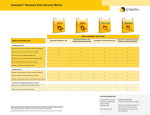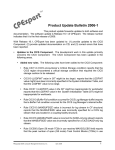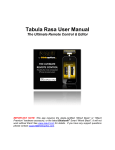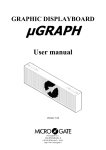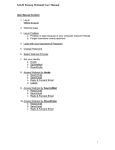Download Exploring web-based groupware tools
Transcript
REVIEWS Web-based Groupware Exploring web-based groupware tools GROUP DYNAMICS Open source groupware tools have come of age. You are no longer limited to email and an address book. Some of these tools surpass the commercial alternatives – once you get them installed. BY JAMES MOHR W eb-based groupware tools offer simplicity for today’s busy workgroup. From any web-ready computer with access to the groupware system, you can read your mail, examine your calendar, and check off items in your ToDo list. But which tool is right for your network? I decided to compare some of the more promising open source, web-based groupware collaboration alternatives. Because I cannot do justice to all of the various products in this growing field, I have limited the study to products for which the emphasis is not on a specific task but, rather, on providing a collection of classic groupware collaboration options such as email, calendaring, contacts, and task management. Some of the shared task components included in this article are simple lists, and others are more like full-blown project management tools. 42 ISSUE 82 SEPTEMBER 2007 For this review, I used Fedora 6 with MySQL 5.0.27 and Apache 2.2.3. Each application was tested with different browsers, and I noticed nothing with the browser access that caused any of the products to fail. All the tools were downloaded from SourceForge, with the exception of Horde, which I obtained from the horde. org website. Each tool in the test was the most current version at the time I wrote this article, and each tool runs as a standard web application, not a standalone server that happens to provide a web front-end. phpGroupWare phpGroupWare is – obviously – written in PHP, and after many years, it's still a 0.x version, with 1.0 planned for late 2007/early 2008. I downloaded and installed version 0.9.16.011. In addition to MySQL, phpGroupWare also supports W W W. L I N U X - M A G A Z I N E . C O M Postgress. Of the alternatives I tested, phpGroupWare seems to provide the largest number of modules by default, although I found a few of the components are not really appropriate in a business environment. Instead of an installer script, you unpack the tgz file in the DocumentRoot of your web server and point your browser to the appropriate URL to set up the products. The installation is very straightforward; I did not have any problems getting it to run the first time. During the install, you create the administrator account, and you have the opportunity to create three demo accounts. Each has a slightly different configuration, which gives you a better feel for what is possible, and you can test the product with “live” data on your own system. Authentication is performed by account information in the database, by accessing an LDAP server, or through email accounts. When considering phpGroupWare for your company, I would go so far as to say that the lack of documentation is sufficient to knock it out of contention. On their website, the documentation pages are either being updated or “cleaned out.” Unfortunately, the docu- Web-based Groupware ments have been in that state for as long as I can remember. What does exist is very thin and scattered throughout various places. Uniformity is lacking as far as what is documented, at what level it is documented, or where the documentation is kept. Although a “manual” exists within the product itself, you often get nothing more than the version number of that particular module. If you do get more, the additional text is still extremely thin and typically just lists what is on the screen. Despite the wide range of useful applications, phpGroupWare often gave me the impression that it is not yet finished and was hurried out the door. Although it is understandable that many different people worked on the different applications and components, it seems to be a patchwork that was almost forced to work together, and the integration between modules is not complete. Of note are a Java application that provides an SSH shell to the local machines, a graphical viewer of files stored in a CVS repository, and a well-rounded project management module (in addition to the usual ToDo list). The project management module allows you to create a multi-level hierarchy of tasks, assign users, define “milestones,” and maintain a budget. Annoyingly, sub-tasks cannot start on the same day as the parent task because the system thinks this is somehow “before” the parent. Overall the product is highly configurable. Access to applications can be assigned to both user and group. In some cases, you can also define a user as an administrator for the specific application (e.g., projects). However, you unfortunately also can still assign access to at least one application that “has been removed from phpGroupWare.” Several different themes display icons and text either at the top of the window or on the left side. In some cases, you can choose text, icons, or even both. Typically, when the icon bar is at the top, module-specific menus are on the left. With the theme I chose, applications are accessed through the menu on the left side of the screen, as you can see in Figure 1; if too many applications are assigned to the user, they do not all appear in the menu. REVIEWS Figure 1: phpGroupWare lets you display the available tools in a menu on the left side of the screen. Another key way you can configure the product is by defining custom fields for a number of the objects – for example, the calendar, address book, and info log. Also, you can change the text for most of the fields if the term used does not suit you. This can also be used to create your own translation for languages that are not available. A number of interesting characteristics can be defined either globally across all objects or only for specific objects. Global characteristics at this level seem to be unique to phpGroupWare and eGroupWare. Several applications had fatal errors – at both the user end and for the administration of the module. Despite googling, posting to the forum, and reading all of the other forum posts with this exact same error, the problem was unresolved. In the case of the address book, I got the start page fine enough, but despite telling the app to display all of the entries, none were shown. One important thing to mention about phpGroupWare is the level of support provided. Although some products have more traffic and questions are answered sooner on average, the phpGroupWare development team definitely deserves a pat on the back for the extent they go to help. In some cases, they have asked for database dumps to be able to locally rec- W W W. L I N U X - M A G A Z I N E . C O M reate the environment to help resolve problems. Having worked with phpGroupWare before, it is disappointing that it has not progressed much in the past couple of years. Still, the work that has gone into it is respectable, and one should not lose sight of it in the future. eGroupWare In 2003, eGroupWare forked from phpGroupWare, primarily because of differences of opinion in terms of licensing (among other things). Although a fork, eGroupWare has definitely surpassed the original. The installation, the configuration, the product itself, and the entire environment surrounding the product gives a more finished impression. A number of subtle (and not so subtle) differences between the two give eGroupWare a very professional feeling. Overall, the installation was like phpGroupWare and went very smoothly. Although I did have a couple of problems, the installation script was very helpful, and I easily fixed these problems. Both eGroupWare and phpGroupWare have the same overall look and feel, and the primary applications are also basically the same. However, eGroupWare provides fewer tools by default, and the tools it does offer at startup are more oriented toward businesses, as opposed ISSUE 82 SEPTEMBER 2007 43 REVIEWS Web-based Groupware Figure 2: eGroupWare is based on a fork of the phpGroupware code base. to phpGroupware’s goal of providing the proverbial kitchen sink. In a number of modules, there are extra applications, as well as more functionality. One additional application is a timesheet that lets you keep track of time spent on different activities. To do this, you can specify one of the projects you define in the project management module and thus have an easy way of tracking your time. Also noteworthy is the Manual/help link at the top of each page. This link provides useful information about the current module. For cases in which no help is available, instead of getting a blank page or a “not found” message, you are brought to the top of the documentation tree. The integration between the applications is much more extensive than with phpGroupWare. For example, when defining a calendar event, you can create links to project tasks, contracts, wiki entries, and even other calendar events. This connection is bidirectional, so that a link to a project task shows the link back to the calendar event. This means that no matter which view you have of the data, you have access to all of the applicable objects. This bidirectionality does not just apply to the information, but activities, as well. For example, you can create a ToDo item directly from an address book 44 ISSUE 82 SEPTEMBER 2007 contact. The ToDo item is then automatically linked back to the contract. One really nice application is the site manager. Here you create a “portal” in which you define blocks that access information from various modules, as well as the layout of the blocks on the page, or you can create multiple portals with different appearances and different sets of applications and permissions. Although also present in phpGroupWare, the eGroupWare version is much more configurable, and you even get a WYSIWYG mode to configure the layout. Horde For the most part, Horde provides a wellrounded groupware application, but it did disappoint me at several different levels. First, I downloaded Horde Groupware Webmail Edition 1.0.1 as a tar archive and tried to install it. Then, I unpacked Horde into the DocumentRoot and started the setup from a PHP script provided with the tool. The script creates the appropriate database and tables. However, for Horde to work, I had to dig through the files provided and change various configuration settings. On the other hand, the documentation overall definitely earns Horde a bonus point or two. Although not written for the Linux newbie, the installation package provides a lot of useful information, including installation, security, and even W W W. L I N U X - M A G A Z I N E . C O M tips on contributing and developing code. The Horde website includes a wiki in addition to the documentation distributed with the product. Unfortunately, however, this documentation was necessary because of the state of the application. To just get the product installed, I had to look through the documentation more than for any application I have installed in years. Sadly, the mailing list was not as helpful as it should be. Although I found posts in which people posed the exact same problems I had, the response from members of the Horde development team was often almost condescending, and I began to wonder if they were at all interested in getting Horde into widespread use or if it was intended solely for an elite group of experts who know how to track down obscure problems. After I got it installed, my joy was short lived because, when attempting to perform the very basic function of adding a user, I got another error message saying it could not access the database. The reason was that the necessary user had not been created. The setup script created the database and asked for the necessary information, so it does not make sense that a user was not created, and I found nothing in the documentation that said it was necessary to create the user by hand. Because I know of ISPs that provide Horde to their users and I am not one to give up easily, I decided to try and install Horde Groupware 1.0.1. This time the installation went much more smoothly. Once I got running, I found a very slick, well-thought out application. All of the features are accessed through the navigation tree similar to a traditional file browser. The toolbar at the top of the window changes depending on the module currently loaded. By default, you will find only four applications: address book, calendar, notes, and tasks. Noticeably missing from that list is an email client. This email client is only available in the Webmail edition, which had failed previously. Fortunately, Horde is modular, so adding the email module was straightforward and went fairly well, considering the problems I had before. Also, there are a few dozen modules that you can download. Web-based Groupware A couple of the administration aspects deserve special mention. First, you have a PHP shell, an SQL shell, and a CLI to execute arbitrary commands. Also, Horde provides a hierarchical permissions structure. In addition, to being able to create users, you can create groups and sub-groups. Then, you can define different permissions for various applications, which you assign to groups or even individual users. As one would expect, each of the individual applications has different configuration options as well. The one aspect that attracted me to Horde in the first place is its homepage “portal,” as you see in Figure 3. With the Layout button, configuring new blocks is very easy. Each block can be configured individually, and you can add or remove blocks, define the layout, and move the blocks around as you see fit. In most cases, you can also configure the behavior of the applet itself. Although you can create multiple address books to which to assign new contacts, unfortunately, the search mechanism does not allow you to search through all address books, so you have to select each one in turn. Also, you can create multiple notepads and task lists. Unlike address books, you can search across all notepads and task lists, so behavior is not consistent. The hierarchy of permissions extends to very specific aspects of the application. For example, you can define the maximum number of notes or calendar entries for a specific group or individual user. Among multiple address books, you can assign access in different ways, such as limiting who can read or edit the addresses. Horde is very easy to navigate, and the interface is one of the more intuitive. However, it is not entirely consistent. For example, menu items underneath the address book and calendar let you add a new entry or search. However, no sub-entries appear under tasks or notes. A new button appears in the address book, but not the calendar, toolbar. Although you can define multiple address books or multiple note books, only the address books appear in the menu, and you can assign a category to calendar entries, but not to contacts. Another aspect worthy of note is the large number of different authentication methods Horde supports. In addition to the SQL-based authentication that basically every groupware tool supports, Horde also comes with support for LDAP, IP-based, Unix passwd, Radius, SMB, IMAP, and even Yahoo, just to name a few. One of the major limitations I found was that the Horde applications are not as well integrated as in other products. For example, users are not automatically added to the list of contacts, or when you set a deadline for a task, it is not added to the calendar. Despite my initial frustrations when installing it and annoyances at a number of the mailing list responses, Horde is still worth taking a look at. IGSuite Despite quite a few problems during the installation, an honorable mention definitely should go to IGSuite. The installation was by far the most frustrating. I searched for documentation, changed parameters, and tinkered with file permissions hoping to get it to work, but after each success, I always ran into one more stumbling block. Noteworthy, however, is the response I got to my forum posts. The first response was within an hour. The response to my reply came as quickly. Over the course of the next couple of days, responses came very quickly after I posted. Although I solved the problem myself, the REVIEWS developers displayed a definite desire to get the problem solved. IGSuite is a Perl-based application that supports the PostgreSQL, MySQL, and SQLite databases. Of note is its use of AJAX, which increases the responsiveness of the application, but in a number of places, the entire frame still was reloaded when AJAX “should” have been able to update just parts of the page. I downloaded and installed version 3.2.3. The initial setup and configuration is done from the command line with a Perl script, which attempts to create the database tables. Whereas setup scripts for other applications ask you for the necessary account information to create the database, or at least tell you to create the database by hand, IGSuite does neither; therefore, it fails during the installation. After I created the database and added the user manually, the install script seemed to go smoothly the second time, and it even remembered my answers to most of the questions. However, when I pointed my browser to the start URL, I ran into a number of inexplicable permissions problems that prevented me from using the product at all. An obvious place to look for answers is the IGSuite website, which is a very odd mixture of Italian and English. Some pages were only available in Italian; in other cases, parts were in English and parts in Italian; links with Italian text led Figure 3: The Horde portal is easy to configure and customize. W W W. L I N U X - M A G A Z I N E . C O M ISSUE 82 SEPTEMBER 2007 45 REVIEWS Web-based Groupware Figure 4: IGSuite offers a professional look and feel – once you get it installed. to English pages or links in English led to pages in Italian. Although I can make a good guess what “documentazione” means, the time I spent in Italy on vacation didn’t help me translate the rest. This also applies to the product itself, in that many things were not translated from the original Italian. When I finally got IGSuite installed and I logged in, I liked the look and feel. The user interface definitely had a more professional appearance than other products. The interface is fairly intuitive, although with several exceptions. By comparison, the applications themselves were very simple, with limited integration between modules. For example, you cannot “invite” people to events in the calendar, and the ToDo list is not hierarchical, so you cannot create subtasks. Also, tasks are not added to the calendar. In addition to the standard applications is a wiki, which curiously opens in a new browser window. This provides a simple editor and supports standard HTML as well as a special wiki markup. One feature worthy of mention is the integration with the HylaFax server. This functionality is optional, but if you do install it, you can manage both outgoing and incoming faxes in a comfortable and easy-to-use interface. IGSuite took a unique approach to organization. The components are broken 46 ISSUE 82 SEPTEMBER 2007 into four different areas: Services, Resources, Protocols, and Controls. Services contain the standard groupware applications. Resources allow you to manage things like “staff” (users), contacts, opportunities, and products, thus forming a good basis for CRM. In fact, looking through all of the various components, it seems that the product is more geared toward CRM than the more traditional groupware tools. The Protocols sections is where you access communications you need to keep track of, such as contracts, offers, letters, faxes, and so forth. The Controls section is used to configure the product at several different levels, although the configuration options are not as extensive as with other products. In addition to defining which application each user can access, you can also assign privileges for the various applications. For example, you can allow users to only view but not edit. As far as I was able to tell, IGSuite only supports user authentication directly through the application (i.e., SQL). However, you can restrict the hosts from which a given user can connect, as well as define when the account expires. An interesting feature is the ability to create an organization chart of your staff. However, before you start, you are told to look at a document on the IGSuite website, which is in Italian. W W W. L I N U X - M A G A Z I N E . C O M One useful tool is a list of “Last Documents,” which shows you the most recent objects you viewed. However, in a couple of instances, when I clicked on an entry, I got a message saying the document was “missing.” When I looked for the specific document, it actually was missing, although I had just created it a couple of minutes ago. Apparently, “Last Documents” stores things that do not actually get changed. One annoying thing about people’s names (for staff and contacts) is that they are a single unit and not separated by first and last names. This means that “Smith, John” is different from “John Smith.” Also, the name is stored in capital letters, so if the person’s last name is LoPorto it is saved as LOPORTO, so you do not know how to write it if you were to send them a letter. Still, one nice aspect is the ability to associate a photo with the staff member (but not contact). One aspect of the IGSuite that I liked was the easy way to define various fields, such as category, contract type, priority, and other fields that have discrete values. Unfortunately, in the case of a characteristic like a category, the definition is not the same for different objects such as calendar entries and ToDo items. IGSuite is a nice attempt to create an efficient groupware tool. Unfortunately, because of the problems I had accessing even the most basic information, I felt it was too difficult to work with. Still, I intend to keep my eye on it. Simple Groupware Written in PHP, the XML-based Simple Groupware supports PostgreSQL, MySQL, and even Oracle databases. I downloaded v0.293, and despite it not having (yet) reached 1.0 status, I was very pleased with almost every aspect of the product. The term “simple” definitely applies to the installation: I had fewer problems installing this tool than the other products. After unpacking the tar file, moving it into the server’s document root, and then loading the default URL, I was presented with a very sleek and simple interface. Access to your information is provided through an interface similar to a traditional hierarchical file browser. This makes sense because applications, infor- REVIEWS Web-based Groupware ware consists of a stack of screenshots that simply name different buttons or portions of the screen. One nice feature was the Edit as New option, which enables you to take an existing object, make changes to the key characteristics, and then save it. This option provides a sort of template functionality. Conclusions mation, and other objects are represented as folders. Like folders on a filesystem, each object is connected to the system via a “mountpoint,” which then shields the user from the connection details. In one of the modules that none of the other groupware tools have, an inventory, resources are the primary objects. Under these resources you have device types, brands, and distributors, which are then characteristics of the specific resource. Rooms can be resources as well, but in the context of Simple Groupware, a room is part of the organization, along with the objects department, offices, position, groups, and users. Of note is a module that provides a simple way to edit HTML files, as well as a spreadsheet module. It is no surprise these tools do not provide the range of features available in a full-blown application, but they are definitely a useful addition. Characteristics like an object's status and category are treated as folders. In essence, this gives you access to each aspect of the system in the same way. This hierarchal structure even extends to the system configuration and information. A very interesting aspect of this product is the Simple Groupware Solutions Markup Language (sgsML), which can be used to add new modules quickly. 48 ISSUE 82 SEPTEMBER 2007 This option is obviously much easier than writing PHP or Perl code. Your new code is then added as a module, which can access other data sources, such as the filesystem, IMAP, and other databases. You can find out more about developing applications with sgsML in the October 2006 issue of Linux Magazine [6]. Another thing I really like about Simple Groupware is that you can notify users when you add or change objects. It has a box with which you select the user, group, or even contacts. Admittedly, I am not too happy with the overall look and feel of Simple Groupware, and I don’t think the interface is as intuitive as the GUIs of the other products. However, Simple Groupware definitely grew on me the more I used it and the more I saw what it could do. Because I am more concerned with configuring the tool to my personal needs, Simple Groupware definitely provides the right tools. This arrangement is far better than having to change the way I work because of the limitations of the software. On the downside, the documentation is very thin and consists primarily of documents describing how to perform specific tasks like data export/import and data synchronization with SyncML. The user manual for Simple Group- W W W. L I N U X - M A G A Z I N E . C O M INFO [1] phpGroupWare: http://www.phpGroupWare.org [2] eGroupWare: http://www.eGroupWare.org [3] Horde: http://www.horde.org [4] IGSuite: http://www.igsuite.org [5] Simple Groupware: http://www.simple-groupware.de [6] “Workspace: Building a Custom Groupware Solution with Simple Groupware,” by Dmitri Popov, Linux Magazine, October 2006, pg. 78 [7] OpenSource CMS site: http://www.opensourcecms.com/ THE AUTHOR Figure 5: Simple Groupware is sensible and easy to install, although the user interface is not exactly intuitive. Every person, every workgroup, every company is different, so finding the perfect tool is likely to be an impossible task. Each of the groupware tools described in this article has characteristics that set it apart. If you want to experiment a bit before you permanently install a groupware application, all of the products – with the exception of Simple Groupware – provide a demo site. If you want to explore some alternative products I didn't discuss in this article, or if you are interested in similar products that are not even specifically classified as groupware, take a look at some of the options provided at the OpenSource CMS site [7]. ■ James Mohr is responsible for the monitoring of several data centers for a business solutions provider in Coburg, Germany. In addition to running the Linux Tutorial website, http://www.linux-tutorial.info, James is the author of several books and dozens of articles on a wide range of topics.






